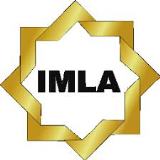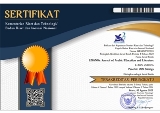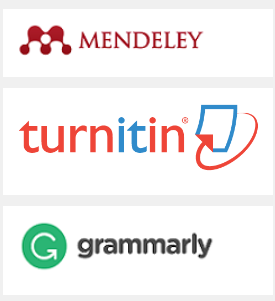Synchronous Learning Model: Innovative Learning Using Saudi Electronic University-Based Learning Management System
DOI:
https://doi.org/10.18326/lisania.v8i1.20-35Keywords:
Synchronous Learning Model, Online Learning, Learning Management System, Saudi Electronic UniversityAbstract
This research aims to explore the implementation of the Synchronous Learning Model (SLM) using a Saudi Electronic University (SEU)-based Learning Management System (LMS), the users’ perceptions, as well as its advantages and disadvantages. A mixed method with a Convergent Parallel model was chosen as the research method, using observation, interviews, and questionnaires distributed to 36 students. Afterward, through the interactive analysis of Miles and Huberman's triangulation, it was discovered that the implementation of SLM with SEU-based LMS in Jambi University was successful, though some challenges, including system weaknesses during evaluation and constraints on internet connectivity, were identified. Therefore, it is recommended that SEU provides improvements to the LMS and the internet access could be improved throughout all regions in Indonesia to facilitate effective and efficient technology utilization in the learning process.
References
Arifin, Z., Desrani, A., Ritonga, A. W., & Ibrahim, F. M. A. (2023). Arabic Language Learning Approach Using Smart Technology in Higher Education. Izdihar : Journal of Arabic Language Teaching, Linguistics, and Literature, 6(1), Article 1. https://doi.org/10.22219/jiz.v6i1.25011
Asmuzi, N. F., Mohamed, Y., & Ismail, S. (2022). Analysis of The Systhematic Literature Review Related to Electronic Teaching and Learning of Arabic for Non-Native Speakers: Analisis Tinjauan Literatur Sistematik Berkaitan Reka Bentuk Pengajaran dan Pembelajaran Elektronik Bahasa Arab untuk Bukan Penutur Jati. Jurnal Pendidikan Bitara UPSI, 15(2), Article 2. https://doi.org/10.37134/bitara.vol15.2.6.2022
Brown, J. D., & Coombe, C. A. (Eds.). (2015). The Cambridge guide to research in language teaching and learning. Cambridge University Press.
Christanty, Z. J., & Cendana, W. (2021). Upaya Guru Meningkatkan Keterlibatan Siswa Kelas K1 dalam Pembelajaran Synchronous. COLLASE (Creative of Learning Students Elementary Education), 4(3), Article 3. https://doi.org/10.22460/collase.v4i3.7154
Creswell, J. W. (2014). Research design: Qualitative, quantitative, and mixed methods approaches (4th ed). SAGE Publications.
Dantes, N., & Handayani, N. N. L. (2021). Peningkatan Literasi Sekolah Dan Literasi Numerasi Melalui Model Blanded Learning Pada Siswa Kelas V SD Kota Singaraja. WIDYALAYA: Jurnal Ilmu Pendidikan, 1(3), Article 3.
Dwijayanthi, A. A. A. (2022). Systematic Literature Review: Pengembangan Pembelajaran Berbasis ICT (Information Communication Technology) Sebagai Upaya Realisasi Kemerdekaan Belajar Peserta Didik. JURNAL PENDIDIKAN MIPA, 12(2), Article 2. https://doi.org/10.37630/jpm.v12i2.606
Fauzi, M. F., & Anindiati, I. (2021). Improving the Motivation of Students in Arabic Language Learning through Learning Management System. Izdihar : Journal of Arabic Language Teaching, Linguistics, and Literature, 4(3), Article 3. https://doi.org/10.22219/jiz.v4i3.19110
Fauzi, M. F., Murdiono, M., Anindiati, I., Nada, A. L. I., Khakim, R. R., Mauludiyah, L., & Thoifah, I. (2020). Developing Arabic Language Instructional Content in Canvas LMS for the Era and Post Covid-19 Pandemic. Izdihar: Journal of Arabic Language Teaching, Linguistics, and Literature, 3(3), Article 3. https://doi.org/10.22219/jiz.v3i3.15017
Ghazali, F. (2022). Towards an optimal blended learning model during disrupted education periods. Pegem Journal of Education and Instruction, 12(3), 97–105. https://doi.org/10.47750/pegegog.12.03.11
Hamidah, R., Permata, C. I. H., Surindra, B., & Irmayanti, E. (2020). Pengaruh Optimalis Pembelajaran Online dan Partisipasi Mahasiswa Terhadap Motivasi Belajar Online Mahasiswa Tingkat II Pendidikan Ekonomi Universitas Nusantara PGRI Kediri. Seminar Nasional Manajemen, Ekonomi Dan Akuntansi, 5(1), Article 1.
Hartanto, W. (2016). Penggunaan E-Learning Sebagai Media Pembelajaran. Jurnal Pendidikan Ekonomi. JURNAL PENDIDIKAN EKONOMI: Jurnal Ilmiah Ilmu Pendidikan, Ilmu Ekonomi Dan Ilmu Sosial, 10(1), Article 1. https://jurnal.unej.ac.id/index.php/JPE/article/view/3438
Herliza, S. R., Yasmin, F. A., Zhafira, N. S., & Wardana, R. A. (2023). Metode System Literature Review Untuk Analisis Penggunaan TIK Sebagai Media Pembelajaran. Jurnal Ilmiah Sistem Informasi Dan Ilmu Komputer, 3(2), Article 2. https://doi.org/10.55606/juisik.v3i2.499
Intiana, S. R. H., Prihartini, A. A., Handayani, F., Mar’i, M., & Faridi, K. (2023). Independent Curriculum and the Indonesian Language Education throughout the Era of Society 5.0: A Literature Review. AL-ISHLAH: Jurnal Pendidikan, 15(1), Article 1. https://doi.org/10.35445/alishlah.v15i1.3140
Løkke Jakobsen, M., Hebert, D. G., & Ørngreen, R. (2023). Synchronous online instrumental music teaching in cross-cultural learning contexts. International Journal of Music Education, 02557614231201916. https://doi.org/10.1177/02557614231201916
Mahsun, M., Ibad, T. N., & Nurissurur, A. (2021). Model Belajar Synchronous dan Ansynchronous Dalam Menghadapi Learning Loss. Bidayatuna Jurnal Pendidikan Guru Mandrasah Ibtidaiyah, 4(1), Article 1. https://doi.org/10.54471/bidayatuna.v4i1.1274
Mardiana, N., & Faqih, A. (2019). Pemanfaatan Learning Management System Dalam Proses Pembelajaran Matematika Diskrit. Jurnal Edukasi Dan Sains Matematika (JES-MAT), 5(1), 16–29. https://doi.org/10.25134/jes-mat.v5i1.1730
Mufidah, N., Isyaty, I., Kholis, N., & Tahir, S. Z. B. (2019). ICT for Arabic Learning: A Blended Learning in Istima’ II. LISANUNA: Jurnal Ilmu Bahasa Arab Dan Pembelajarannya, 8(2), Article 2. https://doi.org/10.22373/ls.v8i2.4561
Mulyani, S., & Sholeh, A. (2023). Paradigma Pembelajaran Bahasa Arab (Analisis Kontrastif Metode Pembelajaran Konvensional dan Kontemporer). Takuana: Jurnal Pendidikan, Sains, dan Humaniora, 2(1), Article 1. https://doi.org/10.56113/takuana.v2i1.71
Mustafa, M., Rohayati, R., Abdullah, A., Alhidayatillah, N., & Astuti, D. P. (2023). From Inequality to Digital Inclusion: Opportunities and Challenges of Digitalization among Santri in Indonesia: Dari Kesenjangan ke Inklusi Digital: Peluang dan Tantangan Digitalisasi di Kalangan Santri di Indonesia. SENTIMAS: Seminar Nasional Penelitian Dan Pengabdian Masyarakat, 319–325.
Pierpaolo, L., & Antonia, T. G. (2023). Smart Learning Environments: Overview of Effective Tools, Methods, and Models. In G. Marques & A. González-Briones (Eds.), Internet of Things for Smart Environments (pp. 1–13). Springer International Publishing. https://doi.org/10.1007/978-3-031-09729-4_1
Prasetyo, T., Marini, A., & Sumantri, M. S. (2021). Kepercayaan dan Kepuasan Penggunaan LMS Mahasiswa Selama Pembelajaran Daring. Jurnal Penjaminan Mutu, 7(2), Article 2. https://doi.org/10.25078/jpm.v7i2.2349
Rachmawati, M., Nugrahawan, A. R., & Rofi’ah, N. H. (2022). The Quizizz Application is an Arabic Online Learning Evaluation Tool at The University Level. Izdihar: Journal of Arabic Language Teaching, Linguistics, and Literature, 5(1), Article 1. https://doi.org/10.22219/jiz.v5i1.20647
Saerang, H. M., Lembong, J. M., Sumual, S. D. M., & Tuerah, R. M. S. (2023). Strategi Pengembangan Profesionalisme Guru di Era Digital: Tantangan dan Peluang. El-Idare: Jurnal Manajemen Pendidikan Islam, 9(1), 65–75. https://doi.org/10.19109/elidare.v9i1.16555
Saudi Electronic University. (2023). About SEU. https://seu.edu.sa/en/about/
Siboro, A., Zupriman Zega, L., & Purba, A. (2022). Pengaruh Model Blended Learning Berbasis Lms (Learning Management System) terhadap Hasil Belajar Siswa SMA. Jurnal Penelitian Fisikawan, 5(1), 1–8.
Solihin, R. (2022). Komunikasi Synchronous dan Asynchronous dalam Blended Learning Pasca Pandemi. Scaffolding: Jurnal Pendidikan Islam Dan Multikulturalisme, 4(2), 279–291. https://doi.org/10.37680/scaffolding.v4i2.1523
Student A. (2022, August 13). Synchronous Learning Model dengan Saudi Elektronic University berbasis LMS [Personal communication].
Student B. (2022, August 13). Synchronous Learning Model dengan Saudi Elektronic University berbasis LMS [Personal communication].
Student C. (2022, August 13). Synchronous Learning Model dengan Saudi Elektronic University berbasis LMS [Personal communication].
Student D. (2022, August 13). Synchronous Learning Model dengan Saudi Elektronic University berbasis LMS [Personal communication].
Student F. (2023, July 20). Synchronous Learning Model dengan Saudi Elektronic University berbasis LMS [Personal communication].
Student G. (2023, July 20). Synchronous Learning Model dengan Saudi Elektronic University berbasis LMS [Personal communication].
Student H. (2023, June 19). Synchronous Learning Model dengan Saudi Elektronic University berbasis LMS [Personal communication].
Sulthoniyah, L. (2022). Implementasi Pembelajaran PAI Melalui E-Learning Model Syncronous—Asynchronous di SMA 04 Ma’arif Perintis Tempurejo Jember. AL-ADABIYAH: Jurnal Pendidikan Agama Islam, 3(2), Article 2. https://doi.org/10.35719/adabiyah.v3i2.395
Syagif, A. (2022). Paradigma Pembelajaran Bahasa Arab di Era Society. FiTUA: Jurnal Studi Islam, 3(2), Article 2. https://doi.org/10.47625/fitua.v3i2.407
Veluvali, P., & Surisetti, J. (2022). Learning Management System for Greater Learner Engagement in Higher Education—A Review. Higher Education for the Future, 9(1), 107–121. https://doi.org/10.1177/23476311211049855
Verawati, N. N. S. P., Hikmawati, H., & Prayogi, S. (2023). Meningkatkan Kemampuan Penalaran Mahasiswa STEM pada Mata Kuliah Fisika Modern melalui Penggunaan Simulasi Virtual pada Platform LMS. Jurnal Ilmiah Profesi Pendidikan, 8(2), Article 2. https://doi.org/10.29303/jipp.v8i2.663
Wiragunawan, I. G. N. (2022). Pemanfaatan Learning Management System (LMS) dalam Pengelolaan Pembelajaran Daring pada Satuan Pendidikan. EDUTECH: Jurnal Inovasi Pendidikan Berbantuan Teknologi, 2(1), Article 1. https://doi.org/10.51878/edutech.v2i1.981
Downloads
Published
Issue
Section
License
Copyright (c) 2024 Muhammad Sobri, Firman Afrian Pratama, Rofiazka Fahmi Huda, Agung Yusup, Huda Salah Rashid

This work is licensed under a Creative Commons Attribution-NonCommercial-ShareAlike 4.0 International License.






